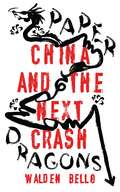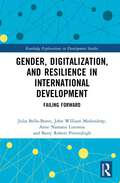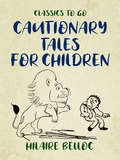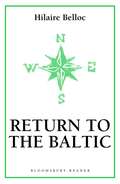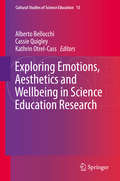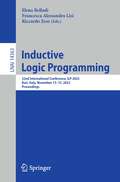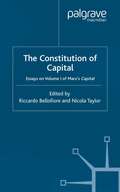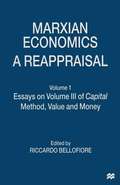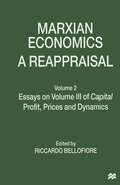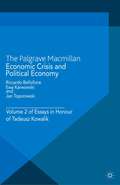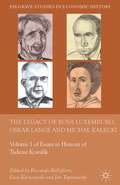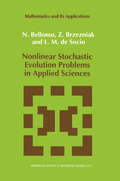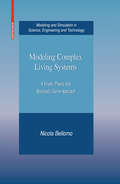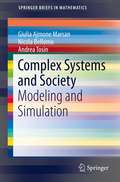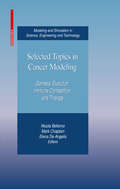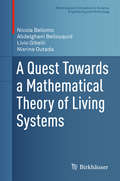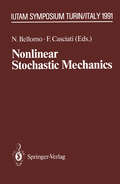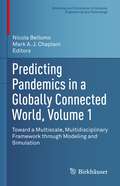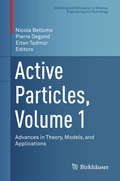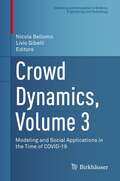- Table View
- List View
Paper Dragons: China and the Next Crash
by Walden BelloEmerging relatively unscathed from the banking crisis of 2008, China has been viewed as a model of both rampant success and fiscal stability. But beneath the surface lies a network of fissures that look likely to erupt into the next big financial crash. A bloated real-estate sector, roller-coaster stock market, and rapidly growing shadow-banking sector have all coalesced to create a perfect storm: one that is in danger of taking the rest of the world's economy with it.Walden Bello traces our recent history of financial crises – from the bursting of Japan's 'bubble economy' in 1990 to Wall Street in 2008 – taking in their political and human ramifications such as rising inequality and environmental degradation. He not only predicts that China might be the site of the next crash, but that under neoliberalism this will simply keep happening. The only way that we can stop this cycle, Bello argues, is through a fundamental change in the ways that we organise: a shift to cooperative enterprise, respectful of the environment, and which fractures the twin legacies of imperialism and capitalism.Insightful, erudite and passionate, Paper Dragons is a must-read for anyone wishing to prevent the next financial meltdown.
Gender, Digitalization, and Resilience in International Development: Failing Forward (Routledge Explorations in Development Studies)
by Julia Bello-Bravo John William Medendorp Anne Namatsi Lutomia Barry Robert PittendrighThis book explores the intersection of gender, digitalization, and resilience in international development. Building resilience is increasingly seen as crucial when planning and implementing development programmes, enabling communities to mitigate, adapt to, and recover from shocks and stresses in a manner that reduces chronic vulnerability and facilitates inclusive growth. Gender plays a crucial role in the resilience of development systems, as the exclusion of women from participation can make communities more vulnerable to economic shocks, perpetuating and even worsening current levels of poverty, instability, and insecurity. Drawing on meta-data from across the world, as well as specific case studies from Ghana, Kenya, Burkina Faso, and Mozambique, this book reflects on these intersections and the potential of digitalization as a democratizing tool for improving the access of women and other marginalized groups to information vital for their participation in the process of development. By outlining the importance of digitalization for addressing gender imbalances, this book draws the evidentiary lines between the role of digitalization for women and resilience as a whole. This book will be of interest to development practitioners and policy makers, as well as researchers with specialisms in gender inclusion, resilience, digitalization, and international development.
Gender, Digitalization, and Resilience in International Development: Failing Forward (Routledge Explorations in Development Studies)
by Julia Bello-Bravo John William Medendorp Anne Namatsi Lutomia Barry Robert PittendrighThis book explores the intersection of gender, digitalization, and resilience in international development. Building resilience is increasingly seen as crucial when planning and implementing development programmes, enabling communities to mitigate, adapt to, and recover from shocks and stresses in a manner that reduces chronic vulnerability and facilitates inclusive growth. Gender plays a crucial role in the resilience of development systems, as the exclusion of women from participation can make communities more vulnerable to economic shocks, perpetuating and even worsening current levels of poverty, instability, and insecurity. Drawing on meta-data from across the world, as well as specific case studies from Ghana, Kenya, Burkina Faso, and Mozambique, this book reflects on these intersections and the potential of digitalization as a democratizing tool for improving the access of women and other marginalized groups to information vital for their participation in the process of development. By outlining the importance of digitalization for addressing gender imbalances, this book draws the evidentiary lines between the role of digitalization for women and resilience as a whole. This book will be of interest to development practitioners and policy makers, as well as researchers with specialisms in gender inclusion, resilience, digitalization, and international development.
Cautionary Tales for Children: Designed For The Admonition Of Children Between The Ages Of Eight And Fourteen Years (classic Reprint) (Classics To Go)
by Hilaire BellocFor readers of any age, a witty and strikingly irreverent collection of moral guidance Most notable among prolific English satirist Hilaire Belloc's writings are the sharp and clever admonishments he composed for children. Collected here and illustrated to wonderful haunting effect by Edward Gorey, these short, funny pieces offer moral instruction for all types of mischief makers—from a certain young Jim, "who ran away from his nurse and was eaten by a lion," to the tale of Matilda, "who told lies and was burned to death”—and add up to a delightful read for any fan of Roald Dahl or Shel Silverstein. (Goodreads)
The Path to Rome
by Hilaire BellocHilaire Belloc's best work — according to the author, as well as most critics — The Path to Rome is less concerned with Rome itself than with a pilgrim's journey to the Eternal City. A spirited Catholic apologist, Belloc traveled on foot from Toul (near Nancy), France, and crossed the Alps and the Apennines in order to, in his words, "see all Europe which the Christian Faith has saved." Afterward, he turned his pen from his usual polemics to literature, and related in finely crafted prose his myriad experiences with the people he met along the way, as well as his reflections on tradition, politics, landscape, and much else. Throughout, the work abounds in Belloc's inimitable wit and good humor, and displays his profound love for the land, his faith, and his fellow man.
Return to the Baltic
by Hilaire BellocHere, Belloc writes of a trip through Sweden and Denmark in 1938, a nostalgic trip taken forty-three years after his first Scandanvian trip in 1895.This volume includes Belloc's history and topography of the area.
Exploring Emotions, Aesthetics and Wellbeing in Science Education Research (Cultural Studies of Science Education #13)
by Alberto Bellocchi Cassie Quigley Kathrin Otrel-CassThis book addresses new research directions focusing on the emotional and aesthetic nature of teaching and learning science informing more general insights about wellbeing. It considers methodological traditions including those informed by philosophy, sociology, psychology and education and how they contribute to our understanding of science education. In this collection, the authors provide accounts of the underlying ontological, epistemological, methodological perspectives and theoretical assumptions that inform their work and that of others. Each chapter provides a perspective on the study of emotion, aesthetics or wellbeing, using empirical examples or a discussion of existing literature to unpack the theoretical and philosophical traditions inherent in those works. This volume offers a diverse range of approaches for anyone interested in researching emotions, aesthetics, or wellbeing. It is ideal for research students who are confronted with a cosmos of research perspectives, but also for established researchers in various disciplines with an interest in researching emotions, affect, aesthetics, or wellbeing.
3D Surface Reconstruction: Multi-Scale Hierarchical Approaches
by Francesco Bellocchio N. Alberto Borghese Stefano Ferrari Vincenzo Piuri3D Surface Reconstruction: Multi-Scale Hierarchical Approaches presents methods to model 3D objects in an incremental way so as to capture more finer details at each step. The configuration of the model parameters, the rationale and solutions are described and discussed in detail so the reader has a strong understanding of the methodology. Modeling starts from data captured by 3D digitizers and makes the process even more clear and engaging. Innovative approaches, based on two popular machine learning paradigms, namely Radial Basis Functions and the Support Vector Machines, are also introduced. These paradigms are innovatively extended to a multi-scale incremental structure, based on a hierarchical scheme. The resulting approaches allow readers to achieve high accuracy with limited computational complexity, and makes the approaches appropriate for online, real-time operation. Applications can be found in any domain in which regression is required. 3D Surface Reconstruction: Multi-Scale Hierarchical Approaches is designed as a secondary text book or reference for advanced-level students and researchers in computer science. This book also targets practitioners working in computer vision or machine learning related fields.
Inductive Logic Programming: 32nd International Conference, ILP 2023, Bari, Italy, November 13–15, 2023, Proceedings (Lecture Notes in Computer Science #14363)
by Elena Bellodi Francesca Alessandra Lisi Riccardo ZeseThis book constitutes the refereed proceedings of the 32nd International Conference on Inductive Logic Programming, ILP 2023, held in Bari, Italy, during November 13–15, 2023.The 11 full papers and 1 short paper included in this book were carefully reviewed and selected from 18 submissions. They cover all aspects of learning in logic, multi-relational data mining, statistical relational learning, graph and tree mining, learning in other (non-propositional) logic-based knowledge representation frameworks, exploring intersections to statistical learning and other probabilistic approaches.
The Constitution of Capital: Essays on Volume 1 of Marx's Capital
by R. Bellofiore N. TaylorThe essays in this collection address specific themes in Volume I of Marx's Capital . Although the essays can be read independently, they present complementary perspectives on issues at the cutting edge of recent scholarship on Marx's work. Although all Parts of Capital I are discussed, the book is not intended to be a textbook. It will be read by specialists in the field as well as graduate students in the history of economic thought, political economy and philosophy.
Marxian Economics: Volume 1: Essays on Volume III of Capital - Method, Value and Money
by Riccardo BellofioreSpringing from a conference held in Bergamo University on the occasion of the centenary of the publication by Engels of the third book of Capital, the papers collected in these two volumes reinstate Marx's as the first genuinely evolutionary economic theory. In this, the capitalist process incessantly brings about states which will by themselves generate the next ones. Thus as Schumpeter remarked, Marx was the first to 'visualise what even at the present time is still the economic theory of the future for which we are slowly and laboriously accumulating stone and mortar, statistical facts and functional equations'.
Marxian Economics: Volume 2 Essays on Volume III of Capital Profit, Prices and Dynamics
by Riccardo BellofioreSpringing from a conference held in Bergamo University on the occasion of the centenary of the publication by Engels of the third book of Capital, the papers collected in these two volumes reinstate Marx's as the first genuinely evolutionary economic theory. In this, the capitalist process incessantly brings about states which will by themselves generate the next ones. Thus as Schumpeter remarked, Marx was the first to 'visualise what even at the present time is still the economic theory of the future for which we are slowly and laboriously accumulating stone and mortar, statistical facts and functional equations'.
Economic Crisis and Political Economy: Volume 2 of Essays in Honour of Tadeusz Kowalik (Palgrave Studies in the History of Economic Thought)
by Riccardo Bellofiore Jan Toporowski Ewa KarwowskiRosa Luxemburg, Oskar Lange and Micha? Kalecki made important contributions to twentieth century political economy that guided the thinking of their student Tadeusz Kowalik. The chapters of this volume examine how the ideas of Luxemburg, Lange, Kalecki and Kowalik can illuminate our understanding of the crisis in twenty-first century capitalism.
The Legacy of Rosa Luxemburg, Oskar Lange and Micha? Kalecki: Volume 1 of Essays in Honour of Tadeusz Kowalik (Palgrave Studies in the History of Economic Thought)
by Riccardo Bellofiore Jan Toporowski Ewa KarwowskiRosa Luxemburg, Oskar Lange and Michal Kalecki made important contributions to twentieth century political economy that guided the thinking of their student Tadeusz Kowalik. These contributions are re-examined by renowned economists, highlighting the common themes in their political economy and the neglected aspects of their work.
Nonlinear Stochastic Evolution Problems in Applied Sciences (Mathematics and Its Applications #82)
by N. Bellomo Zdzislaw Brzezniak L.M. de SocioModeling Complex Living Systems: A Kinetic Theory and Stochastic Game Approach (Modeling and Simulation in Science, Engineering and Technology)
by Nicola BellomoThis book develops new mathematical methods and tools to model living systems. The material it presents can be used in such real-world applications as immunology, transportation engineering, and economics. The first part of the book deals with deriving general evolution equations that can be customized to particular systems of interest in the applied sciences. The second part of the book deals with various models and applications. The book will be a valuable resource to all involved in modeling complex social systems and living matter in general.
Complex Systems and Society: Modeling and Simulation (SpringerBriefs in Mathematics)
by Nicola Bellomo Giulia Ajmone Marsan Andrea TosinThis work aims to foster the interdisciplinary dialogue between mathematicians and socio-economic scientists. Interaction among scholars and practitioners traditionally coming from different research areas is necessary more than ever in order to better understand many real-world problems we face today. On the one hand, mathematicians need economists and social scientists to better address the methodologies they design in a more realistic way; on the other hand, economists and social scientists need to be aware of sound mathematical modelling tools in order to understand and, ultimately, solve the complex problems they encounter in their research. With this goal in mind, this work is designed to take into account a multidisciplinary approach that will encourage the transfer of knowledge, ideas, and methodology from one discipline to the other. In particular, the work has three main themes: Demystifying and unravelling complex systems; Introducing models of individual behaviours in the social and economic sciences; Modelling socio-economic sciences as complex living systems. Specific tools examined in the work include a recently developed modelling approach using stochastic game theory within the framework of statistical mechanics and progressing up to modeling Darwinian evolution. Special attention is also devoted to social network theory as a fundamental instrument for the understanding of socio-economic systems.
Selected Topics in Cancer Modeling: Genesis, Evolution, Immune Competition, and Therapy (Modeling and Simulation in Science, Engineering and Technology)
by Nicola Bellomo Elena De AngelisThis collection of selected chapters offers a comprehensive overview of state-of-the-art mathematical methods and tools for modeling and analyzing cancer phenomena. Topics covered include stochastic evolutionary models of cancer initiation and progression, tumor cords and their response to anticancer agents, and immune competition in tumor progression and prevention. The complexity of modeling living matter requires the development of new mathematical methods and ideas. This volume, written by first-rate researchers in the field of mathematical biology, is one of the first steps in that direction.
A Quest Towards a Mathematical Theory of Living Systems (Modeling and Simulation in Science, Engineering and Technology)
by Nicola Bellomo Abdelghani Bellouquid Livio Gibelli Nisrine OutadaThis monograph aims to lay the groundwork for the design of a unified mathematical approach to the modeling and analysis of large, complex systems composed of interacting living things. Drawing on twenty years of research in various scientific fields, it explores how mathematical kinetic theory and evolutionary game theory can be used to understand the complex interplay between mathematical sciences and the dynamics of living systems. The authors hope this will contribute to the development of new tools and strategies, if not a new mathematical theory.The first chapter discusses the main features of living systems and outlines a strategy for their modeling. The following chapters then explore some of the methods needed to potentially achieve this in practice. Chapter Two provides a brief introduction to the mathematical kinetic theory of classical particles, with special emphasis on the Boltzmann equation; the Enskog equation, mean field models, and Monte Carlo methods are also briefly covered. Chapter Three uses concepts from evolutionary game theory to derive mathematical structures that are able to capture the complexity features of interactions within living systems. The book then shifts to exploring the relevant applications of these methods that can potentially be used to derive specific, usable models. The modeling of social systems in various contexts is the subject of Chapter Five, and an overview of modeling crowd dynamics is given in Chapter Six, demonstrating how this approach can be used to model the dynamics of multicellular systems. The final chapter considers some additional applications before presenting an overview of open problems. The authors then offer their own speculations on the conceptual paths that may lead to a mathematical theory of living systems hoping to motivate future research activity in the field.A truly unique contribution to the existing literature, A Quest Toward a Mathematical Theory of Living Systems is an important book that will no doubt have a significant influence on the future directions of the field. It will be of interest to mathematical biologists, systems biologists, biophysicists, and other researchers working on understanding the complexities of living systems.
Active Particles, Volume 3: Advances in Theory, Models, and Applications (Modeling and Simulation in Science, Engineering and Technology)
by Nicola Bellomo José Antonio Carrillo Eitan TadmorThis edited volume collects six surveys that present state-of-the-art results on modeling, qualitative analysis, and simulation of active matter, focusing on specific applications in the natural sciences. Following the previously published Active Particles volumes, these chapters are written by leading experts in the field and reflect the diversity of subject matter in theory and applications within an interdisciplinary framework. Topics covered include:Variability and heterogeneity in natural swarmsMultiscale aspects of the dynamics of human crowdsMathematical modeling of cell collective motion triggered by self-generated gradientsClustering dynamics on graphsRandom Batch Methods for classical and quantum interacting particle systemsThe consensus-based global optimization algorithm and its recent variantsMathematicians and other members of the scientific community interested in active matter and its many applications will find this volume to be a timely, authoritative, and valuable resource.
Nonlinear Stochastic Mechanics: IUTAM Symposium, Turin, 1991 (IUTAM Symposia)
by Nicola Bellomo Fabio CasciatiThe Symposium, held in Torino (lSI, Villa Gualino) July 1-5, 1991 is the sixth of a series of IUTAM-Symposia on the application of stochastic analysis to continuum and discrete mechanics. The previous one, held in Innsbruck (1987), was mainly concentrated on qual itative and quantitative analysis of stochastic dynamical systems as well as on bifurcation and transition to chaos of deterministic systems. This Symposium concentrated on fundamental aspects (stochastic analysis and mathe matical methods), on specific applications in various branches of mechanics, engineering and applied sciences as well as on related fields as analysis of large systems, system identifica tion, earthquake prediction. Numerical methods suitable to provide quantitative results, say stochastic finite elements, approximation of probability distribution and direct integration of differential equations have also been the object of interesting presentations. Specific topics of the sessions have been: Engineering Applications, Equivalent Lineariza tion of Discrete Stochastic Systems, Fatigue and Life Estimation, Fluid Dynamics, Numerical Methods, Random Vibration, Reliability Analysis, Stochastic Differential Equations, System Identification, Stochastic Control. We are indebted to the IUTAM Bureau for having promoted and sponsored this Sympo sium and the Scientific Committee for having collaborated to the selection of participants and lecturers as well as to a prompt reviewing of the papers submitted for publication into these proceedings. A special thank is due to Frank Kozin: the organization of this meeting was for him ';ery important; he missed the meeting but his organizer ability was present.
Active Particles, Volume 1: Advances in Theory, Models, and Applications (Modeling and Simulation in Science, Engineering and Technology)
by Nicola Bellomo Pierre Degond Eitan TadmorThis volume collects ten surveys on the modeling, simulation, and applications of active particles using methods ranging from mathematical kinetic theory to nonequilibrium statistical mechanics. The contributing authors are leading experts working in this challenging field, and each of their chapters provides a review of the most recent results in their areas and looks ahead to future research directions. The approaches to studying active matter are presented here from many different perspectives, such as individual-based models, evolutionary games, Brownian motion, and continuum theories, as well as various combinations of these. Applications covered include biological network formation and network theory; opinion formation and social systems; control theory of sparse systems; theory and applications of mean field games; population learning; dynamics of flocking systems; vehicular traffic flow; and stochastic particles and mean field approximation. Mathematicians and other members of the scientific community interested in active matter and its many applications will find this volume to be a timely, authoritative, and valuable resource.
Active Particles, Volume 2: Advances in Theory, Models, and Applications (Modeling and Simulation in Science, Engineering and Technology)
by Nicola Bellomo Pierre Degond Eitan TadmorThis volume compiles eight recent surveys that present state-of-the-art results in the field of active matter at different scales, modeled by agent-based, kinetic, and hydrodynamic descriptions. Following the previously published volume, these chapters were written by leading experts in the field and accurately reflect the diversity of subject matter in theory and applications. Several mathematical tools are employed throughout the volume, including analysis of nonlinear PDEs, network theory, mean field approximations, control theory, and flocking analysis. The book also covers a wide range of applications, including:Biological network formationSocial systemsControl theory of sparse systemsDynamics of swarming and flocking systemsStochastic particles and mean field approximationsMathematicians and other members of the scientific community interested in active matter and its many applications will find this volume to be a timely, authoritative, and valuable resource.
Crowd Dynamics, Volume 3: Modeling and Social Applications in the Time of COVID-19 (Modeling and Simulation in Science, Engineering and Technology)
by Nicola Bellomo Livio GibelliThis contributed volume explores innovative research in the modeling, simulation, and control of crowd dynamics. Chapter authors approach the topic from the perspectives of mathematics, physics, engineering, and psychology, providing a comprehensive overview of the work carried out in this challenging interdisciplinary research field. In light of the recent COVID-19 pandemic, special consideration is given to applications of crowd dynamics to the prevention of the spreading of contagious diseases. Some of the specific topics covered in this volume include: - Impact of physical distancing on the evacuation of crowds- Generalized solutions of opinion dynamics models- Crowd dynamics coupled with models for infectious disease spreading- Optimized strategies for leaders in controlling the dynamics of a crowdCrowd Dynamics, Volume 3 is ideal for mathematicians, engineers, physicists, and other researchers working in the rapidly growing field of modeling and simulation of human crowds.
